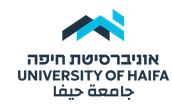
Prof. Motti Zohar
School of Environmental Sciences
Environmental Sciences & Geospatial Information Sciences
Biography
Motti Zohar is an associate professor at the School of Environmental Sciences, University of Haifa, specializing in Environmental Sciences and Geospatial Information Sciences. His research applies GIScience, GeoAI, and Earth Observation to examine human–environment interactions. He is a member of the Climate and Environmental Sustainability Center, the National Knowledge and Research Center for Emergency Readiness and the Chaikin Chair for Geostrategy, contributing to the study of environmental processes, societal change, and historical contexts. Since 2021, he has led the GIScience Environmental Lab, fostering interdisciplinary research on past environmental scenarios through advanced geospatial methodologies.
He earned his BA (1998) from the Hebrew University of Jerusalem and his MA (2006) from Tel Aviv University. His PhD, completed in 2016 at the Department of Geography, Hebrew University of Jerusalem, examined earthquake damage patterns in Israel and its vicinity based on historical sources. From 2016 to 2018, he was a postdoctoral fellow in the Department of Physical Geography at the Freie Universität Berlin, where he focused on applying geospatial methodologies to environmental research.
In addition to his research, Professor Zohar mentored undergraduate students in their early academic stages and supervises MA and PhD students, as well as postdoctoral fellows. Beyond academia, he serves as a consultant for public and private sector organizations, particularly on projects related to natural disaster mitigation, resilience, and preparedness. He collaborates with Israeli and international academic bodies and initiatives, fostering connections between research and practical applications.
Before entering academia, Professor Zohar worked in the IT industry as an enterprise system analyst and project manager for GIS Software development. In these roles, he gained extensive experience in designing and implementing complex geospatial systems, managing multidisciplinary teams, and integrating advanced technological solutions into organizational workflows. He was also involved in several startups, contributing to their growth through innovative software solutions, strategic adoption of emerging technologies, and the translation of conceptual ideas into practical, market-ready products.
Research Interests
Geospatial Information Science for examining the interplay between the human & natural environments: exploration of how human activities shape—and are shaped by—natural landscapes using geospatial technologies.
Spatiotemporal patterns associated with the occurrences of natural hazards and risks: understanding where and when natural hazards such as floods, wildfires, and earthquakes occur and why.
The development of GIScience themes, approaches & geoanalytics tools: advancing new methods for data analysis, visualization, and spatial reasoning to tackle complex environmental questions.
Earth observation for monitoring natural and human-induced processes: Satellite imagery and remote sensing data to monitor changes in land use, vegetation, urban growth, and environmental degradation.
Landscapes & historical scenes reconstruction using GeoAI: applying Artificial Intelligence to spatial data to bridge classical environmental research with modern methodologies.
For additional info visit: OrcId | Google scholar | ResearchGate | Linkedin | Facebook | Twitter (X) | YouTube
Activity Map
A visual representation of POIs (Points of Interest), sites, locations and areas associated with the following research themes:
- The study of historical earthquakes, particularly in the Levant. The project includes collection and inspection of structural damage, archaeological evidence of past seismic activity, paleoseismological data, and historical insights related to events occurred in the pre-instrumental era (that is, before the invention of the first modern seismograph)
- The reconstruction of past climate of the Negev (Israel) during late antiquity and early medieval periods. This project contains the examination of geomorphological, geological, archaeological, natural proxies, and historical data indicating of past climatic properties and potential changes
- Examine fire, floods, volcanoes, and climate extremes through GIS-based hazard mapping, proxy datasets, and remote sensing, evaluating risk patterns and environmental drivers of natural disasters over time.
- Analyze spatial distributions and evolution of human settlements—linking urban growth, land use change, and resilience—using historical maps, remote sensing, and spatial statistics to explore human–environment dynamics.
- Map Ottoman-era Jerusalem through archival sources, historic cartography, and GIS to reveal urban structure, cultural landscapes, administrative boundaries, and spatial transformations in historical context.


